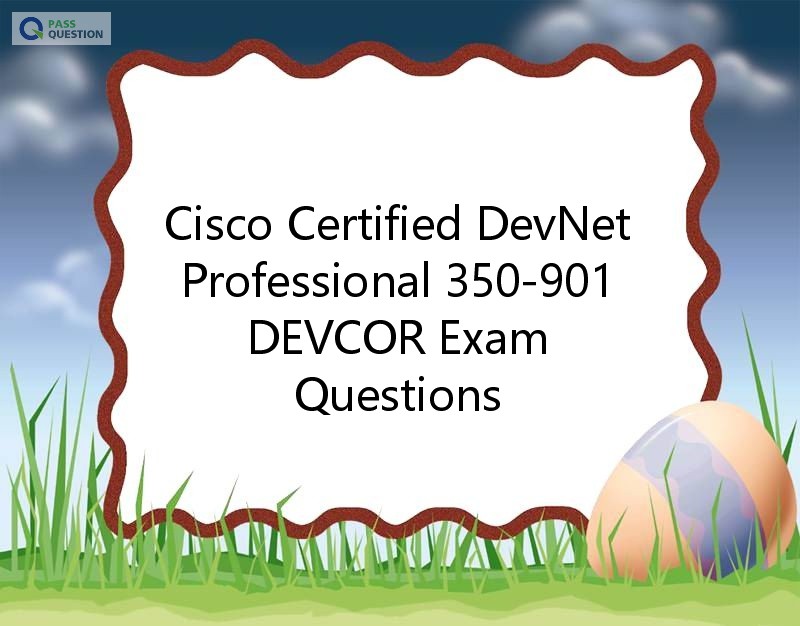Cisco Certified DevNet Professional 350-901 DEVCOR Exam Questions
Are you looking for ways on how to prepare for your Cisco 350-901 DEVCOR Exam in a short time? PassQuestion Cisco Certified DevNet Professional 350-901 DEVCOR Exam Questions are designed to help candidates learn exam knowledge better. 350-901 questions and answers are a great way to improve a candidate score and this would definitely provide you with better prospects of DevNet Professional Certification 350-901 learning.

Cisco Certified DevNet Professional Core Exam - 350-901 DEVCOR Exam
The Developing Applications Using Cisco Core Platforms and APIs v1.0 (DEVCOR 350-901) exam is a 120-minute exam associated with the Cisco Certified DevNet Professional certification. This exam tests a candidate's knowledge of software development and design including using APIs, Cisco platforms, application deployment and security, and infrastructure and automation.
To earn DevNet Professional, you pass two exams, a core exam and a software developer concentration exam of your choice. And now every exam in the DevNet Professional program earns an individual Specialist certification, so you get recognized for your accomplishments along the way.
350-901 DEVCOR Exam Topics - Developing Applications Using Cisco Core Platforms and APIs (DEVCOR)
This exam tests your knowledge of software development and design, including:
Software Development and Design
Using APIs
Cisco platforms
Application Deployment and Security
Infrastructure and Automation
View PassQuestion Cisco Certified DevNet Professional 350-901 DEVCOR Free Questions
1.A developer has created an application based on customer requirements. The customer needs to run the application with the minimum downtime.
Which design approach regarding high-availability applications, Recovery Time Objective, and Recovery Point Objective must be taken?
A. Active/passive results in lower RTO and RPO. For RPO, data synchronization between the two data centers must be timely to allow seamless request flow.
B. Active/passive results in lower RTO and RPO. For RPO, data synchronization between the two data centers does not need to be timely to allow seamless request flow.
C. Active/active results in lower RTO and RPO. For RPO, data synchronization between the two data centers does not need to be timely to allow seamless request flow.
D. Active/active results in lower RTO and RPO. For RPO, data synchronization between the two data centers must be timely to allow seamless request flow.
Answer: A
2.A cloud native project is being worked on in which all source code and dependencies are written in Python, Ruby, and/or JavaScnpt. A change in code triggers a notification to the CI/CD tool to run the CI/CD pipeline.
Which step should be omitted from the pipeline?
A. Deploy the code to one or more environments, such as staging and/or production.
B. Build one of more containers that package up code and all its dependencies.
C. Compile code.
D. Run automated tests to validate the correctness.
Answer: A
3.Which two statements are considered best practices according to the 12-factor app methodology for application design? (Choose two.)
A. Application code writes its event stream to stdout.
B. Application log streams are archived in multiple replicated databases.
C. Application log streams are sent to log indexing and analysis systems.
D. Application code writes its event stream to specific log files.
E. Log files are aggregated into a single file on individual nodes.
Answer: AD
4.An organization manages a large cloud-deployed application that employs a microservices architecture. No notable issues occur with downtime because the services of this application are redundantly deployed over three or more data center regions.
However, several times a week reports are received about application slowness. The container orchestration logs show faults in a variety of containers that cause them to fail and then spin up brand new.
Which action must be taken to improve the resiliency design of the application while maintaining current scale?
A. Update the base image of the containers.
B. Test the execution of the application with another cloud services platform.
C. Increase the number of containers running per service.
D. Add consistent “try/catch(exception)” clauses to the code.
Answer: D
5.How should a web application be designed to work on a platform where up to 1000 requests per second can be served?
A. Use algorithms like random early detection to deny excessive requests.
B. Set a per-user limit (for example, 5 requests/minute/user) and deny the requests from the users who have reached the limit.
C. Only 1000 user connections are allowed; further connections are denied so that all connected users can be served.
D. All requests are saved and processed one by one so that all users can be served eventually.
Answer: D
6.Which two situations are flagged by software tools designed for dependency checking in continuous integration environments, such as OWASP? (Choose two.)
A. publicly disclosed vulnerabilities related to the included dependencies
B. mismatches in coding styles and conventions in the included dependencies
C. incompatible licenses in the included dependencies
D. test case failures introduced by bugs in the included dependencies
E. buffer overflows to occur as the result of a combination of the included dependencies
Answer: AE
- TOP 50 Exam Questions
-
Exam
All copyrights reserved 2025 PassQuestion NETWORK CO.,LIMITED. All Rights Reserved.

